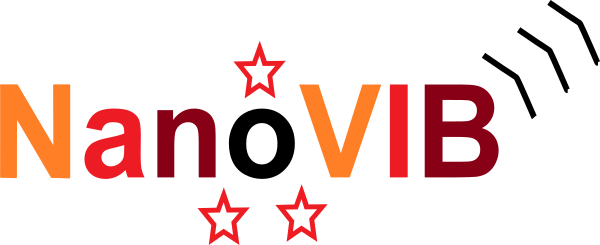Open lectures session
Open session within the framework of the NanoVIB Horizon 2020 project
Near-IR Nanoscopy and Vibrational Microscopy
Read more at:
16th May 2023, FB54, Albanova University Center, Stockholm
and on Zoom at
https://kth-se.zoom.us/j/62429164481
Open session within the framework of the NanoVIB Horizon 2020 project
Near-IR Nanoscopy and Vibrational Microscopy
Read more at:
16th May 2023, FB54, Albanova University Center, Stockholm and on Zoom at
https://kth-se.zoom.us/j/62429164481
Program
| 13:00 - 13:05 : | Welcome, Introduction and brief project presentation Jerker Widengren, KTH Royal Institute of Technology, Stockholm |
| 13:05 - 13:55 : | MINFLUX nanoscopy and related matters Stefan W. Hell, Max Planck Institute for Multidisciplinary Sciences, Göttingen & Max Planck Institute for Medical Research, Heidelberg |
| 14:00 - 15:00 : | Next generation super-resolution MINFLUX platform Andreas Schönle, Abberior Instruments GmbH, Göttingen Single photon counting detector arrays Michel Antolovic, PI Imaging Technology SA, Lausanne Lasers for Stimulated Raman Scattering (SRS) imaging Ingo Rimke, Angewandte Physik & Elektronik (APE) GmbH, Berlin Multimodal instrument integration Alexander Egner, Institut für Nanophotonik (IFNANO), Göttingen Fluorophore photophysics and imaging procedures Jerker Widengren, KTH Royal Institute of Technology, Stockholm Biomedical perspectives and lead application Birgitta Henriques-Normark, Karolinska Institutet, Stockholm |
MINFLUX nanoscopy and related matters
Stefan W. Hell
Max Planck Institute for Multidisciplinary Sciences, Göttingen & Max Planck Institute for Medical Research, Heidelberg
Abstract
I will show how an in-depth description of the basic principles of diffraction-unlimited fluorescence microscopy (nanoscopy) [1-3] has spawned a new powerful superresolution concept, namely MINFLUX nanoscopy [4]. MINFLUX utilizes a local excitation intensity minimum (of a doughnut or a standing wave) that is targeted like a probe in order to localize the fluorescent molecule to be registered. In combination with single-molecule switching for sequential registration, MINFLUX [4-7] has obtained the ultimate (super)resolution: the size of a molecule. MINFLUX nanoscopy, providing 1–3 nanometer resolution in fixed and living cells, is presently being established for routine fluorescence imaging at the highest, molecular- size resolution levels. Relying on fewer detected photons than popular camera-based localization, MINFLUX and related MINSTED [8,9] nanoscopies are poised to open a new chapter in the imaging of protein complexes and distributions in fixed and living cells. MINFLUX is also set to transform the single-molecule analysis of dynamic processes, as already demonstrated by tracking in detail the unhindered stepping of the motor protein kinesin- 1 on microtubules at up to physiological ATP concentrations [10], and providing answers to longstanding questions with respect to the kinesin-1 mechanochemical cycle.
[1] Hell, S.W., Wichmann, J. Breaking the diffraction resolution limit by stimulated emission: stimulated-emission-depletion fluorescence microscopy. Opt. Lett. 19, 780-782 (1994).
[2] Hell, S.W. Far-Field Optical Nanoscopy. Science 316, 1153-1158 (2007).
[3] Hell, S.W. Microscopy and its focal switch. Nat. Methods 6, 24-32 (2009).
[4] Balzarotti, F., Eilers, Y., Gwosch, K. C., Gynnå, A. H., Westphal, V., Stefani, F. D., Elf, J., Hell, S.W. Nanometer resolution imaging and tracking of fluorescent molecules with minimal photon fluxes. Science 355, 606-612 (2017).
[5] Eilers, Y., Ta, H., Gwosch, K. C., Balzarotti, F., Hell, S. W. MINFLUX monitors rapid molecular jumps with superior spatiotemporal resolution. PNAS 115, 6117-6122 (2018).
[6] Gwosch, K. C., Pape, J. K., Balzarotti, F., Hoess, P., Ellenberg, J., Ries, J., Hell, S. W. MINFLUX nanoscopy delivers 3D multicolor nanometer resolution in cells. Nat. Methods 17, 217–224 (2020).
[7] Schmidt, R., Weihs, T., Wurm, C. A., Jansen, I., Rehman, J., Sahl, S. J., Hell, S. W. (2021) MINFLUX nanometer-scale 3D imaging and microsecond-range tracking on a common fluorescence microscope. Nat. Commun. 12:1478.
[8] Weber, M., Leutenegger, M., Stoldt, S., Jakobs, S., Mihaila, T. S., Butkevich, A. N., Hell, S. W. MINSTED fluorescence localization and nanoscopy. Nat. Photon. 15, 361-366 (2021).
[9] Weber, M., von der Emde, H., Leutenegger, M., Gunkel, P., Sambandan, S., Khan, T. A., Keller- Findeisen, J., Cordes, V. C., Hell, S.W. MINSTED nanoscopy enters the Ångström localization range. Nat. Biotechnol., 41, 569-576 (2023).
[10] Wolff, J.O., Scheiderer, L., Engehard, T., Engelhardt, J., Matthias, J., Hell, S.W. MINFLUX dissects the unimpeded walking of kinesin-1
Science, 379, 1004-1010 (2023).


